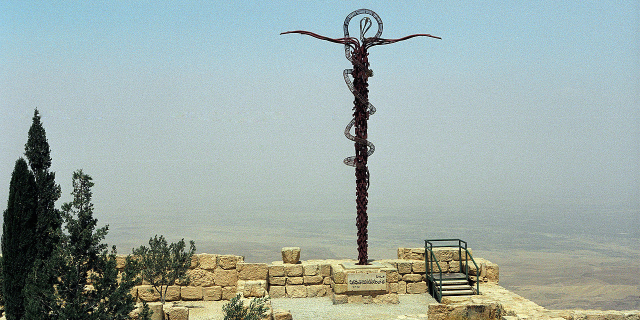وادي الموجب
( Wadi Mujib )The Wadi Mujib (Arabic: وادي الموجب, Wadi el-Mujib), also known as Arnon Stream (Hebrew: נַחַל ארנון), is a river in Jordan. The river empties into the Dead Sea circa 420 metres (1,380 ft) below sea level. Today, the Wadi Mujib is fed by seven tributaries. The western part of the river is the site of the Mujib Biosphere Reserve, popular for hikes & canyoning amid dramatic rock formations.
 Gorge of the River Arnon Near Its Mouth. From Stade, "Geschichte des Volkes Israel."Iron Age and biblical narrative
Gorge of the River Arnon Near Its Mouth. From Stade, "Geschichte des Volkes Israel."Iron Age and biblical narrative
Wadi Mujib, or the Arnon Stream as it was known in biblical times, has always been an important boundary-line. According to the Hebrew Bible, it once separated the Moabites from the Amorites (Numbers 21:13–26; Deuteronomy 3:8; Judges 11:18).
Following the Israelite settlement the stream divided, theoretically at least, Moab from the tribes of Reuben and Gad (Deuteronomy 3:12–16). But Moab, in fact, lay as much to the north as it did to the south of the Arnon. To the north, for example, were Aroer, Dibon, Medeba, and other Moabite towns. Even under Omri and Ahab, who held part of the Moabite territory, Israel did not hold sway farther south than Ataroth, about ten miles north of the Arnon.
Mesha, King of Moab, in his inscription (Mesha Stele, line 10) says that the Gadites (not the Reubenites) formerly occupied Ataroth, whence he in turn expelled the people of Israel. He mentions (line 26) his having constructed a road along the Arnon. The ancient importance of the river and of the towns in its vicinity is attested by the numerous ruins of bridges, forts, and buildings found upon or near it. Its fords are alluded to by the Book of Isaiah (16:2). Its "heights," crowned with the castles of chiefs, were also celebrated in verse (Numbers 21:28).
Hellenistic and Roman periodsIn Roman times, a fort garrisoned by Cohors III Alpinorum, known as Apud Arnona, was situated close to the point where the Via Nova route crossed the Arnon river. One of the river's confluents, Seil Heidan, was known in Roman times as Aidonas.[1]




























Add new comment